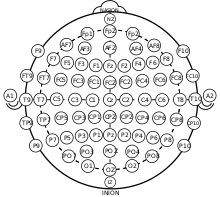10–20 system (EEG)

The 10–20 system or International 10–20 system is an internationally recognized method to describe and apply the location of scalp electrodes in the context of an EEG test or experiment. This method was developed to ensure standardized reproducibility so that a subject's studies could be compared over time and subjects could be compared to each other. This system is based on the relationship between the location of an electrode and the underlying area of cerebral cortex. The "10" and "20" refer to the fact that the actual distances between adjacent electrodes are either 10% or 20% of the total front–back or right–left distance of the skull.
Each site has a letter to identify the lobe and a number to identify the hemisphere location. The letters F, T, C, P and O stand for frontal, temporal, central, parietal, and occipital lobes, respectively. (Note that there exists no central lobe; the "C" letter is used only for identification purposes.) Even numbers (2,4,6,8) refer to electrode positions on the right hemisphere, whereas odd numbers (1,3,5,7) refer to those on the left hemisphere. A "z" (zero) refers to an electrode placed on the midline. In addition to these combinations, the letter codes A, Pg and Fp identify the earlobes, nasopharyngeal and frontal polar sites respectively.
Two anatomical landmarks are used for the essential positioning of the EEG electrodes: first, the nasion which is the distinctly depressed area between the eyes, just above the bridge of the nose; second, the inion, which is the lowest point of the skull from the back of the head and is normally indicated by a prominent bump.
Higher-resolution systems

When recording a more detailed EEG with more electrodes, extra electrodes are added using the 10% division, which fills in intermediate sites halfway between those of the existing 10–20 system. This new electrode-naming-system is more complicated giving rise to the Modified Combinatorial Nomenclature (MCN). This MCN system uses 1, 3, 5, 7, 9 for the left hemisphere which represents 10%, 20%, 30%, 40%, 50% of the inion-to-nasion distance respectively. The introduction of extra letter codes allows the naming of intermediate electrode sites. Note that these new letter codes do not necessarily refer to an area on the underlying cerebral cortex.
The new letter codes of the MCN for intermediate electrode places are:
- AF – between Fp and F
- FC – between F and C
- FT – between F and T
- CP – between C and P
- TP – between T and P
- PO – between P and O
Also, the MCN system renames four electrodes of the 10–20 system:
- T3 is now T7
- T4 is now T8
- T5 is now P7
- T6 is now P8
A higher-resolution nomenclature has been suggested and called the "5% system" or the "10–5 system".[1]
References
- ↑ Oostenveld, Robert; Praamstra, Peter (2001). "The five percent electrode system for high-resolution EEG and ERP measurements". Clinical Neurophysiology. 112: 713–719. CiteSeerX 10.1.1.116.7379
 . doi:10.1016/S1388-2457(00)00527-7.
. doi:10.1016/S1388-2457(00)00527-7.
- Jasper, Herbert H. (May 1958). "Report of the committee on methods of clinical examination in electroencephalography: 1957" (PDF). Electroencephalography and Clinical Neurophysiology. 10 (2): 370–375. doi:10.1016/0013-4694(58)90053-1.
- G.E. Chatrian, E. Lettich, and P.L. Nelson. Ten percent electrode system for topographic studies of spontaneous and evoked EEG activity. Am J EEG Technol, 25:83-92, 1985.
- American Electroencephalographic Society. Guidelines for standard electrode position nomenclature. J Clin Neurophysiol, 8:200-202, 1991.
- American Electroencephalographic Society. Guideline thirteen: Guidelines for standard electrode position nomenclature. J Clin Neurophysiol, 11:111-113, 1994.
- M.R. Nuwer, C. Comi, R. Emerson, A. Fuglsang-Frederiksen, J-M. Guérit, H. Hinrichs, A. Ikeda, F.J.C. Luccas, and P. Rappelsburger. IFCN standards for digital recording of clinical EEG. Electroencephalogr Clin Neurophysiol, 106:259-261, 1998.
- G.H. Klem, H.O. Lüders, H.H. Jasper, and C. Elger. The ten-twenty electrode system of the International Federation. Electroencephalogr Clin Neurophysiol, Supplement 52:3-6, 1999.
- Ernst Niedermeyer, Fernando Lopes da Silva, Electroencephalography: Basic Principles, Clinical Applications, and Related Fields - Page 140, Lippincott Williams & Wilkins, 2004 ISBN 0-7817-5126-8, ISBN 978-0-7817-5126-1.
External links
- SVG drawing of the 10-20 system (numbering seen as a subset of the 10% division) (PDF)
- 10-20 System (numbering seen as a subset of the 10% division)